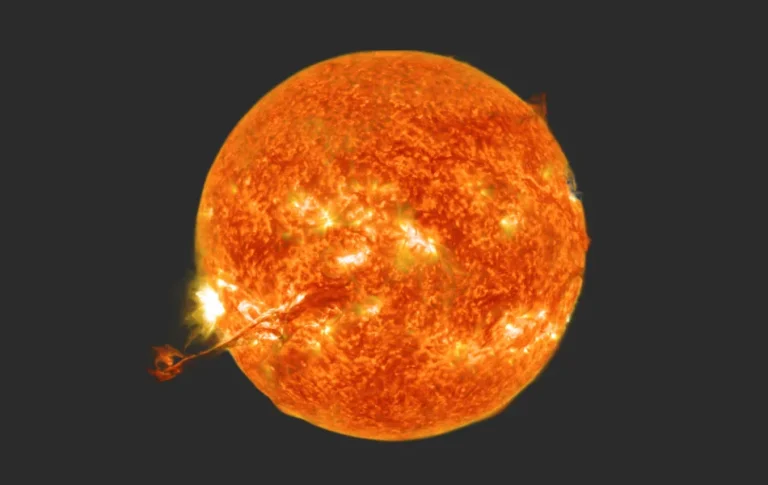This is a really positive thing since it might eventually lead to better solar storm predictions.
According to studies that were published in the magazine Nature, contemporary research indicates that the magnetic field of the sun originates near to the surface of the star rather than deep within the star itself. This contradicts the conventional wisdom in the scientific community, which for many decades had held that the field was located more than 130,000 miles below the surface of the sun. In addition to this, it puts us one step closer to comprehending the characteristics of the magnetic field of the sun, a topic that has been on the minds of scientists ever since Galileo.
The findings of the study, which were headed by experts from Northwestern University and a group of researchers from other countries, indicate that the magnetic field is actually generated 20,000 miles below the surface. Following a series of difficult computations that were carried out on a NASA supercomputer, the team came to this realization. It is important to bring to your attention that these are merely preliminary findings, and that additional research is necessary to validate the data.
Over the course of eleven years, the magnetic field of the sun undergoes a cycle of fluctuation. The most intense phase of this cycle is characterized by the formation of violent winds and sunspots in the solar equator, as well as plumes of material that are responsible for the aurora borealis phenomenon that occurs on Earth. Previous ideas that seek to situate the magnetic field deeper within the sun have struggled to establish a connection between the many solar phenomena that have been seen. In the case that additional research is conducted, scientists have high hopes that they will be able to use this hypothesis to not only explain the formation of solar events, but also to more correctly anticipate when they will take place.
Each second, 1.5 million tons of solar material, traveling at 100 miles per second, shoot off the sun. Earth's magnetic field deflects most of it, but not all. The solar wind, a stream of charged particles, flows at 447 km/s (1 million mph), and while the magnetic field protects… pic.twitter.com/40CSNZYesU
— Historic Vids (@historyinmemes) January 1, 2024
It is possible that this will lead to more than just earlier predictions of the next event involving the aurora borealis. The strong magnetic energy of the sun is also the source of solar flares and coronal mass ejections, which are eruptions of plasma that occur across the sun. Whenever these ejections make their way toward Earth, a wide variety of undesirable events take place. This is a well-known event that took place in the year 1859, when a massive geomagnetic storm is responsible for producing the greatest solar storm ever documented.
The astronomer Richard Christopher Carrington, who was from the United Kingdom, is credited with naming this phenomenon the Carrington Event. During a brief period of time, the solar flare, which was actually a magnetic explosion on the surface of the sun, caused colored lights to explode all around the earth, in a manner that was comparable to the aurora borealis. In addition to that, it accelerated the motion of telegraph cables, shocked operators, and caused telegraph paper to catch fire. It was a horrible experience.
Now, this was the year 1859, before the widespread usage of electricity, before computers, and before any other technology that was connected to these things. We would be in a lot more precarious situation if something similar to the Carrington Event were to take place now. Electronic devices, radio transmissions, and satellite communications would all be disrupted by the X-rays and ultraviolet light that were emitted. An incident of this nature would result in a solar radiation storm, which would be fatal to astronauts who were not fully protected by their protective gear systems.
In addition to this, it would cause a coronal mass ejection to collide with the magnetic field of the Earth, which would result in the shutdown of electricity grids, satellites for mobile phones, contemporary automobiles, and even airplanes. As a consequence, power disruptions could occur all around the world for several months. Even while it was not a Carrington-sized catastrophe, the storm that occurred a month ago caused some disruptions to electrical devices on a relatively minor scale. What’s even more terrible? The time has come for this to take place unquestionably. In essence, it is a time bomb that is ticking away.
It is also possible that these findings could be utilized in the development of new early warning mechanisms for large-scale solar flares that are aimed at the Earth. In the future, we might be able to receive warnings about solar flares in addition to hurricane warnings and other such signals. Sunspots and the magnetic activity of the sun have already been shown to have some interesting connections, as the research has already proven.
In an interview with The Hill, the principal author of the study, Geoffrey Vasil of the University of Edinburgh, stated that “we still do not understand the sun properly enough to make accurate predictions” on solar weather. The co-author of this study, Daniel Lecoanet of Northwestern University, stated that these new discoveries “will be an important step toward finally resolving” this mysterious process.

